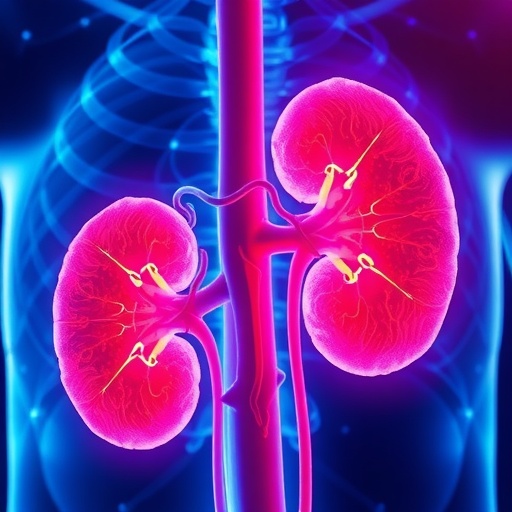In recent years, the global rise of diabetes has catalyzed extensive research into its many complications, among which diabetic kidney disease (DKD) remains one of the most debilitating and least understood. The study led by Zhao and colleagues, published in Nature Communications in 2025, sheds new light on the molecular mechanisms underpinning DKD progression, with a particular focus on the role of branched-chain amino acids (BCAAs) and cellular metabolic reprogramming. This groundbreaking work elucidates how BCAAs influence podocyte health through PKM2-mediated metabolic pathways, revealing critical insights that may pave the way for innovative therapeutic strategies.
Diabetic kidney disease manifests as a gradual decline in renal function triggered by chronic hyperglycemia and associated metabolic derangements. Podocytes, the specialized epithelial cells that wrap around the glomerular capillaries, play a vital role in maintaining the kidney’s filtration barrier. Damage or loss of podocytes is a hallmark of DKD, leading to proteinuria and eventual kidney failure. Understanding the cellular and metabolic changes within podocytes under diabetic conditions is, therefore, essential for unraveling the pathophysiology of DKD.
This study focuses on branched-chain amino acids, particularly leucine, isoleucine, and valine, which are not only essential nutrients but also potent regulators of cellular metabolism and signaling pathways. Elevated circulating levels of BCAAs have been observed in metabolic diseases such as diabetes and obesity, correlating with insulin resistance and cardiovascular risks. However, their direct impact on kidney cells, especially podocytes, and contribution to DKD progression remained elusive until now.
By dissecting the metabolic landscape of podocytes exposed to high glucose conditions and supplemented with BCAAs, Zhao et al. reveal a significant metabolic shift driven by pyruvate kinase M2 (PKM2), a key glycolytic enzyme known for its role in cancer metabolism and cellular adaptation to stress. The team demonstrates that BCAAs trigger PKM2 activation, promoting a metabolic reprogramming in podocytes from oxidative phosphorylation towards aerobic glycolysis, often referred to as the “Warburg effect.” This reprogramming is linked with increased production of reactive oxygen species (ROS) and mitochondrial dysfunction, which are potent inducers of podocyte apoptosis.
The mechanistic exploration goes deeper, showing that BCAAs induce PKM2 expression and nuclear translocation, where PKM2 acts beyond its metabolic role. In the nucleus, PKM2 functions as a transcriptional coactivator, modulating genes related to apoptosis and cellular stress responses. This dual functionality amplifies the deleterious impact of elevated BCAAs on podocyte survival under diabetic conditions. Such findings highlight a novel non-metabolic role of PKM2, bridging metabolism with gene regulation in DKD.
In vivo studies in diabetic mice models fortified the in vitro observations. Mice fed with high BCAA diets exhibited accelerated kidney injury marked by increased proteinuria, podocyte loss, and glomerulosclerosis. Genetic or pharmacological inhibition of PKM2 attenuated these effects, underscoring the enzyme’s pivotal role in mediating the harmful consequences of BCAA accumulation. These interventions improved mitochondrial efficiency and reduced oxidative stress within the podocytes, thereby preserving their function and integrity.
The implications of this research extend to the broader understanding of diabetic complications. It shifts the paradigm from viewing BCAAs merely as metabolic substrates to recognizing them as active signaling entities capable of altering cellular fate via key metabolic enzymes such as PKM2. This notion aligns with an emerging trend that metabolic intermediates can act as signaling molecules, directly influencing disease progression beyond traditional pathways.
Moreover, the discovery of PKM2’s role opens potential therapeutic avenues. Current DKD treatments largely focus on glycemic control and hypertension management, with limited efficacy in halting podocyte loss. Targeting the PKM2-mediated metabolic reprogramming pathway could represent a novel strategy to intercept podocyte apoptosis and preserve kidney function. Drugs modulating PKM2 activity or BCAA metabolism may emerge as candidates for adjunctive therapy in diabetic patients at risk of nephropathy.
This work also sparks important questions about dietary BCAA intake and its systemic effects on metabolic health. While BCAAs are often supplemented for muscle health, particularly in athletes and elderly populations, their elevated levels may harbor unintended risks, especially in individuals with metabolic vulnerabilities. Careful nutritional interventions considering BCAA metabolism may be warranted to balance benefits and potential renal hazards.
Technically, Zhao et al. employed state-of-the-art metabolomics, transcriptomics, and advanced imaging techniques to map out the cellular alterations induced by BCAAs in cultured podocytes and animal models. Single-cell RNA sequencing further allowed the resolution of heterogeneous cell responses within the glomerulus, delineating which subsets are most susceptible to metabolic stresses. This comprehensive methodological approach strengthens the robustness of the findings and provides a solid framework for future investigations.
Beyond diabetic nephropathy, the interplay between BCAA metabolism and PKM2 activity may have broader relevance in other chronic kidney diseases and metabolic disorders. The study prompts investigations into whether similar metabolic reprogramming occurs in other renal cell types or organ systems affected by diabetes. It also raises the potential integration of metabolic enzyme inhibitors in multi-target therapeutic regimens.
The convergence of metabolic and transcriptional reprogramming emphasizes a sophisticated network where nutrient signals translate into gene expression changes, ultimately dictating cellular fate decisions. Understanding this nexus in podocytes enriches the landscape of metabolic disease research and uncovers a critical vulnerability that can be exploited for clinical benefit.
In conclusion, Zhao and colleagues have unveiled a compelling narrative linking branched-chain amino acids with diabetic kidney disease progression through the PKM2-mediated metabolic and transcriptional programming of podocytes. Their findings represent a paradigm shift in understanding DKD pathogenesis, integrating metabolic signaling with cellular survival mechanisms. This research not only advances scientific knowledge but also ignites hope for novel, targeted interventions to combat one of the most serious complications of diabetes.
Subject of Research: The contribution of branched-chain amino acids to diabetic kidney disease progression through PKM2-mediated podocyte metabolic reprogramming and apoptosis.
Article Title: Branched-chain amino acids contribute to diabetic kidney disease progression via PKM2-mediated podocyte metabolic reprogramming and apoptosis.
Article References:
Zhao, H., Sun, D., Wang, S. et al. Branched-chain amino acids contribute to diabetic kidney disease progression via PKM2-mediated podocyte metabolic reprogramming and apoptosis. Nat Commun 16, 7846 (2025). https://doi.org/10.1038/s41467-025-62890-9
Image Credits: AI Generated




